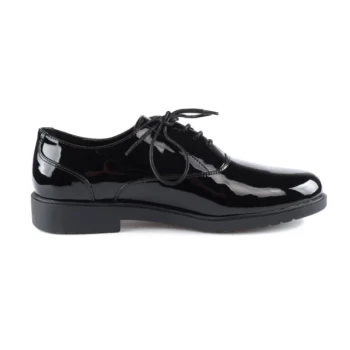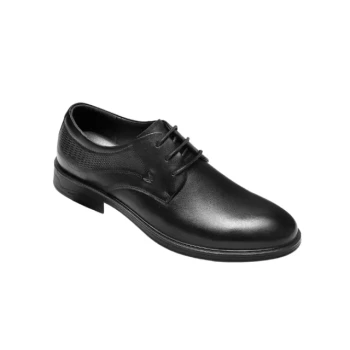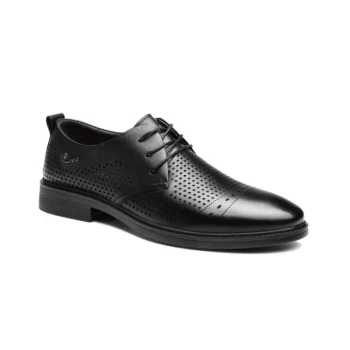The Oxford shoe is not an invention, but an evolution. It traces its direct lineage to Oxford University in the 1800s, where students began wearing a modified, low-cut version of the popular high boots of the era. This new style, initially a side-laced boot called the 'Oxonian,' was a subtle act of rebellion against the more restrictive footwear of the time.
The core identity of the Oxford shoe lies not in its name, but in its construction. It evolved from a student boot into the quintessential dress shoe because of one defining feature: its closed lacing system, which creates an elegant, streamlined silhouette.
From Bulky Boots to a Sleeker Profile
The story of the Oxford is one of refinement. It represents a shift in menswear towards practicality and a more understated form of elegance, moving away from the cumbersome boots that were standard for gentlemen.
The 'Oxonian' Precursor
The direct ancestor of the Oxford was the Oxonian boot. This was a half-boot, popular among university students, that featured a narrow slit on its side for fastening, making it more comfortable than the taller, more rigid boots common in the early 19th century.
The Key Evolutionary Changes
Over time, the Oxonian boot underwent several critical modifications. The side slit was replaced with laces, which eventually moved to the center instep. The heel was lowered, and the entire shoe was cut lower on the ankle, resulting in the shoe we recognize today.
The Defining Feature: Understanding "Closed Lacing"
More than any other detail, the lacing system is what makes an Oxford an Oxford. This specific construction method is directly responsible for its formal reputation.
What is a Closed Lacing System?
In an Oxford, the pieces of leather that hold the lace eyelets (the quarters) are stitched underneath the front part of the shoe (the vamp).
When the laces are tied, these eyelet tabs are pulled together, creating a clean, seamless appearance with no visible tongue flap except for a small portion at the very top. The tongue itself is a separate piece of leather sewn in beneath this lacing panel.
The Impact on Fit and Formality
This "closed throat" construction gives the Oxford its characteristically snug fit and sleek, uninterrupted profile. This minimalist design is what makes it the standard for business attire, formal wear, and black-tie events.
Understanding the Trade-offs
While celebrated for its elegance, the Oxford's design has inherent benefits and limitations that are important to understand.
The Benefit: An Unmatched Formal Aesthetic
The primary advantage of the closed lacing system is its clean, formal appearance. It creates a smooth, continuous line along the top of the shoe that pairs perfectly with the sharp tailoring of a suit.
The Limitation: Less Flexibility in Fit
The closed lacing system offers less adjustability than other shoe designs. Individuals with a high instep may find the shoe too restrictive, as the stitched-down vamp does not allow for much expansion.
How to Identify and Wear the Oxford
Understanding the shoe's origin and construction allows you to use it with purpose and identify it correctly.
- If your primary focus is formal wear: The Oxford's clean lines make it the definitive choice for business suits, tuxedos, and other formal attire.
- If you are trying to identify a true Oxford: Ignore the broguing or color and look directly at the laces; the eyelet tabs should be stitched under the front of the shoe, creating a 'V' shape when tied.
The Oxford shoe remains a cornerstone of classic style because its design was perfected through function and a desire for refinement.
Summary Table:
| Key Aspect | Details |
|---|---|
| Origin | Oxford University, 1800s (evolved from the 'Oxonian' boot) |
| Defining Feature | Closed Lacing System (quarters stitched under the vamp) |
| Primary Use | Formal wear, business suits, and black-tie events |
| Key Benefit | Unmatched sleek, formal, and streamlined silhouette |
| Consideration | Less adjustable fit, can be restrictive for high insteps |
Ready to step into quality footwear?
As a large-scale manufacturer, 3515 produces a comprehensive range of footwear for distributors, brand owners, and bulk clients. Our production capabilities encompass all types of shoes and boots, including classic styles like the Oxford.
We can help you bring refined, high-quality footwear to your market. Contact us today to discuss your manufacturing needs!
Related Products
- Wholesale Training Shoes with Dial Lacing System Custom OEM Manufacturing
- Wholesale Leather Derby Shoes Manufacturer | Customizable Business & Dress Footwear
- Wholesale Patent Oxford Dress Shoes | Custom & Bulk Manufacturing
- Durable Rubber-Soled Utility Shoes for Wholesale & Custom Brand Manufacturing
- Wholesale Breathable Training Shoes Custom Athletic Footwear Manufacturer
People Also Ask
- What is a stylish way to wear heeled lace-up boots? Master the Art of Stylish Contrast
- Why are lace-up shoes generally preferred over slip-ons? Unlock Superior Support & Stability
- How have sneaker brands incorporated camouflage patterns? From Military to Streetwear Style
- How do athletic shoes with non-slip features differ from regular ones? Discover the Grip Advantage
- What is a Flyknit shoe? The Ultimate Guide to Seamless, Lightweight Performance



















